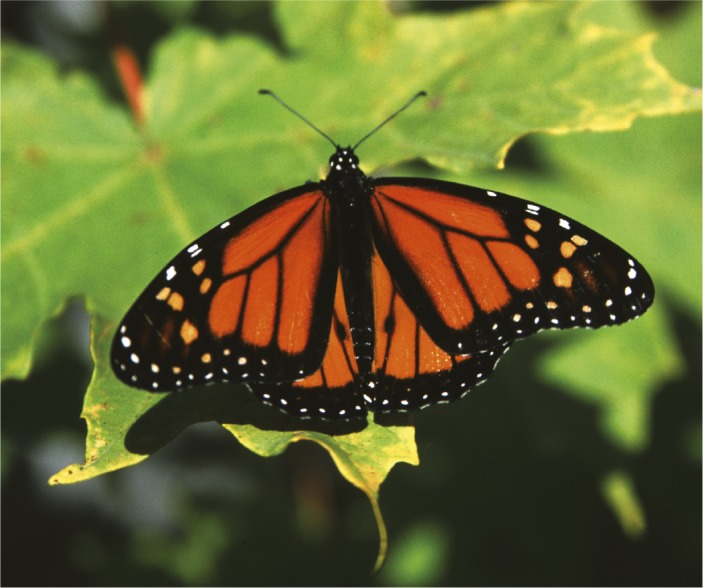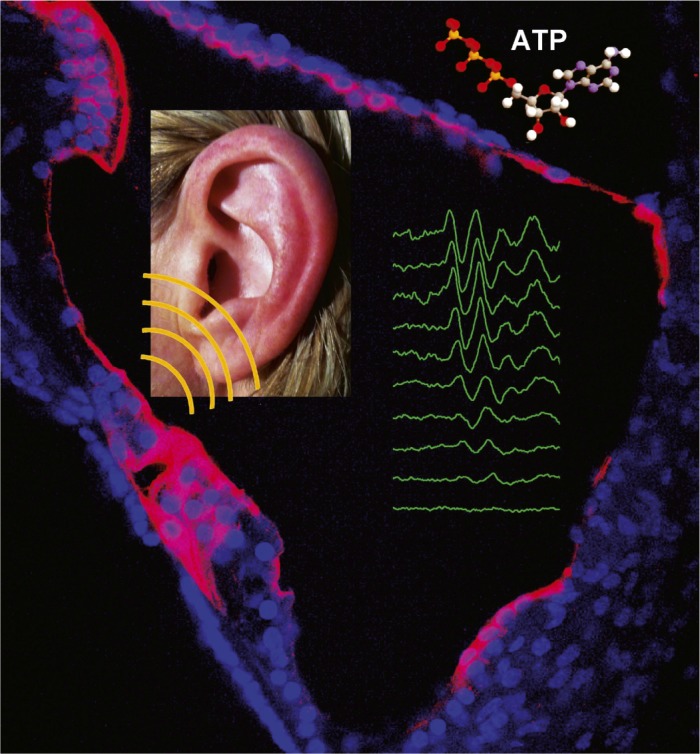Navigation strategy of monarch butterflies

Monarch butterfly, released after participating in flight simulator experiments.
During their first weeks of life, monarch butterflies in eastern North America migrate up to 4,000 km to overwintering sites in Mexico, but the insects’ navigation strategy remains unclear. True navigators possess both an internal map and compass, and know their geographical location and which direction to travel, whereas vector navigators lack a map and orient themselves using only an internal compass. To distinguish between these strategies, Henrik Mouritsen et al. (pp. 7348–7353) used flight simulators to track the migratory direction of 23 migrating monarchs captured in Ontario, Canada, and found that the butterflies flew in a southwesterly direction toward their overwintering grounds. When these individuals were displaced 2,500 km westward to Alberta, Canada, they continued to orient toward the southwest, suggesting that they were unable to compensate for the displacement. The authors also analyzed the distribution of 422 tagged and recaptured monarchs collected between 1952 and 2004, and found that these data generally agreed with two mathematical models of vector navigation. The tagged monarch data also suggested that geographic barriers, such as the Atlantic Ocean, Gulf of Mexico, and Rocky Mountains, may help guide the butterflies toward their destination. The findings suggest that monarchs use only a compass to migrate and are not true navigators, according to the authors. — N.Z.
Range expansion helps maintain cooperation during evolution
Natural populations often expand their geographical range, whether through population growth, environmental change, or adaptation. Theoretical studies have shown that range expansions likely influence evolution, but the underlying mechanisms remain unclear partly because expanding populations are difficult to study in the natural environment. Using a yeast experimental system with controlled migration parameters, Manoshi Datta et al. (pp. 7354–7359) examined how range expansion affects cooperative behaviors during evolution. Evolutionary biologists have yet to fully explain why the phenomenon of providing a benefit to other members of a population at a cost to oneself originated and why this phenomenon remains a persistent feature of natural selection. According to the authors, range expansion strongly enriches cooperation at the leading edge of the expanding population, in mixed populations of cooperators, and so-called “defectors,” which exploit benefits without incurring the cost of cooperation. Furthermore, the authors demonstrated that geographic expansions can provide cooperators with an opportunity to outrun defectors. The findings reveal that range expansions enhance cooperation by coupling population and evolutionary dynamics, and provide experimental evidence of two previously unreported mechanisms for maintaining cooperation in nature, according to the authors. — T.J.
Developmental timing of acute lymphoblastic leukemia
Monozygotic twins with acute lymphoblastic leukemia (ALL) provide an opportunity to decipher the timeline of genetic events in the onset of the disease. By comparing whole genome sequences of twins’ diseased cells, researchers can distinguish in utero mutations, which twins share via mechanisms that allow mutated blood cells to pass between fetuses, from postnatal mutations, which are unique to each twin. Yussanne Ma et al. (pp. 7429–7433) performed whole genome sequencing of cells from two monozygotic twin pairs with ALL. One pair had the ETV6-RUNX1 mutation, commonly associated with ALL but not sufficient to cause disease. The other twin pair did not have this mutation. ETV6-RUNX1 was the only protein-encoding mutation that the ETV6-RUNX1-positive twin pair shared, suggesting that the mutation was the in utero initiating lesion. The other twin pair also shared a small number of single nucleotide variants that likely primed the cells to become leukemic. In both sets of twins, the authors found unique mutations that apparently occurred after birth. The authors suggest that only a small number of those mutations complemented the initiating lesions and triggered disease in the individual children. The majority were noncoding “passenger” mutations acquired as the leukemic cells proliferated. The findings may help uncover the molecular onset of ALL, according to the authors. — B.A.
Repurposing an antimycotic drug to suppress P. aeruginosa

Flucytosine protects mice from lethal P. aeruginosa pulmonary infection.
As the spread of drug resistance among pathogenic bacteria limits the efficacy of antibiotics, repurposing old drugs may help speed antimicrobial drug development. Francesco Imperi et al. (pp. 7458–7463) used the bacterial pathogen Pseudomonas aeruginosa, the leading cause of chronic lung infection in patients with cystic fibrosis, as a target for the screening of antivirulence activity among marketed drugs. Multidrug-resistant P. aeruginosa poses a tremendous challenge to traditional antibiotic therapy, and the researchers found that the antimycotic agent flucytosine, a US Food and Drug Administration-approved compound, suppressed P. aeruginosa virulence in vitro and in an animal model. Flucytosine inhibited the expression of the P. aeruginosa iron-starvation sigma factor PvdS, thereby repressing the production of PvdS-dependent virulence factors such as the siderophore pyoverdine, the extracellular protease PrpL, and exotoxin A. Flucytosine administration also suppressed P. aeruginosa pathogenicity in a mouse model of lung infection, consistent with the essential role played by PvdS during pulmonary infections. The desirable pharmacological properties of flucytosine and its in vitro and in vivo activity against P. aeruginosa suggest that the antimycotic drug might be a promising candidate for the development of a treatment targeting P. aeruginosa virulence, according to the authors. — S.R.
Snow cover decrease influences hare camouflage
Seasonally timed events such as mating and hibernation depend on climate. However, linking specific climate change scenarios to the consequences of disrupted seasonal events often requires disentangling complex responses that span trophic levels and nonclimate-related confounding factors. L. Scott Mills et al. (pp. 7360–7365) investigated coat color changes that camouflage snowshoe hares against snow-covered backgrounds; the color changes are triggered by photoperiod, a timing mechanism unaffected by the presence of snow. To assess whether the initiation and rate of seasonal molts can respond to shortened snow seasons, the authors monitored 148 wild snowshoe hares at a study site in Western Montana during a fortuitous 3-year period that included the shortest and longest regional snow seasons since 1970. Combining the data with projections of climate and snowpack duration, the authors estimated that reduced snow cover during the next century will increase by three- to eight-fold the number of days that white hares must spend on dark, snowless terrain. The findings offer a visually compelling link between a specific climate change scenario and mismatched seasonal events. According to the authors, the findings might have implications for nine or more mammals that rely on seasonal coat color for camouflage. — T.J.
ATP signaling enables adaptation to loud sounds

P2X2 receptor-type ATP-gated ion channels in the mouse cochlear partition.
The mammalian auditory system can process sounds ranging from a whisper to a wailing siren. Researchers have long studied the mechanisms that allow the cochlea to transduce loud sounds without damage, given that sustained noise from sources like industrial workplaces and personal music players can exacerbate age-related hearing loss. Gary Housley et al. (pp. 7494–7499) demonstrate that increases in sound intensity trigger a release of ATP into the cochlear partition, activating proteins called P2X2 receptors and reducing sound transduction and synaptic transmission from cochlear cells. The authors report that mice deficient in the P2RX2 gene, which encodes P2X2 receptors, lack a hearing-protective response known as “temporary threshold shift” when exposed to a sustained sound level of 85 dB. Furthermore, the authors report that P2RX2-null mice are more vulnerable to permanent hearing loss than wild-type mice at sound levels above 95 dB. The authors attribute this vulnerability to a lack of ATP-activated conductance across the cochlear partition and suggest that ATP-gated ion channels assembled from P2X2 receptor subunits might underlie hearing adaptation that sustains cochlear function at high sound levels. — T.J.


